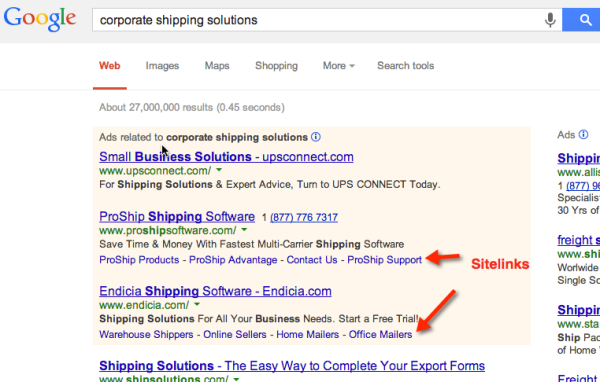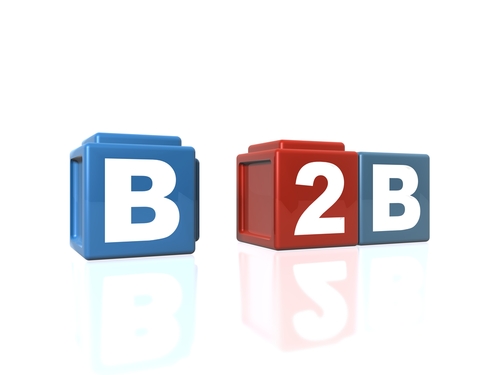We all know B2B customers differ from regular consumers for a variety of reasons. Their purchase cycle is longer, as they have to consult more options before pulling the trigger on signing a contract for a solution or purchasing a product. There is also more risk involved when a B2B client finally makes a purchase, as the success of their business may hinge on the decisions they make.
We also know it’s critical for paid search to be present to finally close the loop on the sale or lead when that B2B client is ready. But when the search engine results page is a sea of text ads and organic listings, how does the B2B advertiser ensure that it stands out against the competition? With CPCs so expensive for B2B advertisers, how can these businesses get the most bang for their buck (and that click that will seal the deal)?
The answer lies in rich ad formats. Following are three of the richer formats that B2B advertisers can use to differentiate themselves on the search engine results page.
1. Use Google & Bing Sitelinks
This is definitely a no-brainer (and has been for a while), but is still worth mentioning. Plenty of B2B advertisers in premium positioning on Google and Bing are not using sitelinks to help diversify their listing and allow B2B customers to segment themselves, especially on main brand and generic terms.

Leveraging sitelinks is an easy way help the customer get to the right place sooner and also capture more real estate on the search engine results page (and leave less space above the fold for competitors). For example, a catering business can use sitelinks to drive potential customers to learn more about breakfast, lunch and dinner options — or to request a quote for an event and complete the lead. Similarly, a shipping company can utilize sitelinks to qualify the customer into quantity of products shipped or even modes of transport, if that’s an option.
Chances are the B2B advertiser has plenty to offer in terms of service or product, depending on the audience and searcher. Test multiple variations and combinations of sitelinks to understand what customers are looking for and how the ad resonates.
If stumped on generating the first round of sitelinks, one great way to start is to look at site paths — where the customer goes first, second, third and fourth after clicking through the ad. And, of course, don’t forget to enhance sitelinks and write the additional description text to capture more eyeballs when the ad serves.
2. Get Images In Your Ads
One ad format that has really taken off this year is the Product Listing Ad. It’s been so successful that Bing is pushing to launch its own offering as well. The reason for the effectiveness of PLAs is simple — seeing what you’re about to buy in an image puts potential customers at ease and saves them additional clicks searching through your site.
If you’re a B2B advertiser in e-commerce and are not currently live with Product Listing Ads, you are missing valuable sales. PLAs are an easy way to instantly compare products and pricing for B2B offerings against competitors quickly and efficiently.
Another way to differentiate with images on the SERPs is with Google Image Extensions. This format is another great way to feature the product or solution in use by customers (or in different use cases), and of course, own more ad space above the fold.
On Yahoo, one way to use images is to upload the company’s logo as a Favicon to serve next to the ad in search results. For B2B advertisers that want to stand out in a crowded marketplace where competitors may be serving ads on brand terms, this is a quick and easy way to ensure customers have trust that your ad is the official site searched for.
![]()
3. Use Video
Research indicates that B2B customers are spending more time with video than ever before. The videos that they’re engaging with are longer than an average commercial, and they watch the video to the end, as opposed to bouncing off the video after a few seconds.
If you have a YouTube channel, opportunity exists through TrueView in-search ads to help drive customers to your channel and content when the customer searches on YouTube for content that’s relevant to your brand.
Once that potential customer is watching the video and engaging with your offering, launch overlays on the video to help take the customer further — back to your site where they can continue to build the brand relationship.
Similarly, you can launch video overlays that will serve ads on competitors’ videos and other videos relevant to your brand’s offering. This helps raise awareness about your brand and also keeps your brand in the consideration set for the product or solution.
On Bing, video can be leveraged through an ad format called Rich Ads In Search. These ads only serve on branded terms, but have higher click-through rates and allow for the customer to view video content relevant to the search without leaving the SERP.
Rich Ads in Search also contain sitelinks for further diversification of traffic. Rich Ads In Search only serve ads in position one, and take up all three premium positions on the search engine results page. These ads are a great way to control visibility on branded keywords and showcase video content that appeals to the B2B audience.
Make Yourself Visible In The SERPs!
As the search engine results page continues to become more competitive, CPCs for B2B solutions and products continue to rise in an already expensive landscape. Each click is that much more valuable than the last, so B2B brands must continue to differentiate themselves on the SERPs of Google, Bing and Yahoo.
Leveraging rich ad formats such as sitelinks, images and video will help B2B brands build trust and own real estate on the SERPs for key terms. Images and video will also help to feed awareness and consideration as the B2B customer researches before making final purchasing decisions.
Contributing authors are invited to create content for Search Engine Land and are chosen for their expertise and contribution to the search community. Our contributors work under the oversight of the editorial staff and contributions are checked for quality and relevance to our readers. The opinions they express are their own.



